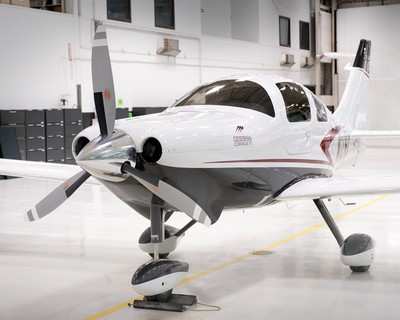Kansas Aircraft Reaches Point of Know [sic] Return
The National Transportation Safety Board (NTSB) has released its final report on a 05 February 2021 accident in which a Columbia Aircraft MFG. (formerly Lancair) LC42-550FG aircraft operated under Part 91 of the Federal Aviation Regulations suffered substantial damage after departing the end of Runway 17 at Larned, Kansas’s Pawnee County Airport (LQR).

At approximately 12:00 CST on the afternoon of 05 February 2021, a Columbia Aircraft MFG. LC42-550FG, registration N115FP—a single-reciprocating-engine, low-wing, fixed-undercarriage, general aviation aircraft comprising extensive composite construction—was readied by the owner/private-pilot to fly him and a pilot-rated passenger to a nearby airport for purpose of picking up an airplane.
The pilot commenced a take-off on LQR’s Runway 35 but aborted the effort when the aircraft failed to become airborne. The pilot subsequently reported the aircraft’s engine had operated normally during the take-off roll, and normal takeoff acceleration had been achieved.
After approximately ten-minutes, the pilot attempted a second take-off from the reciprocal Runway 17—as LQR winds had shifted to 270° at 14-knots, gusting to 19-knots.
The aircraft began its take-off roll, attained lift-off speed, and again failed to become airborne.
Consistent with the first take-off attempt, the pilot reported the aircraft’s engine and flight controls had operated normally. The pilot further noted, however, that during the second take-off attempt the airplane’s brakes “faded.”
The aircraft departed the end of Runway 17 and entered a dry grassy area of the airport property. The pilot then observed smoke emitting from the plane’s left and right main landing-gear.
The pilot and his passenger exited the airplane, and hastened to retrieve a fire-extinguisher from a nearby FBO. Upon returning to the accident site, the pilot attempted to use the extinguisher on the burning wheels and brakes. Regrettably, the extinguisher failed to function.
The pilot fetched a second fire-extinguisher from the FBO and returned to the accident site to find the fire had spread to the aircraft’s left wing, resulting in substantial damage to the structure’s underside skin and spar.

Initial post-accident examination of the LC42-550FG’s left and right brake assemblies found the mechanisms to be mechanically intact and free of anomaly—excepting fire damage. The aircraft’s parking brake had not been engaged at the time of the accident. Flight-control continuity was confirmed from the cockpit to the entirety of the aircraft’s flight-control surfaces. The airplane was determined to be under its Maximum Gross Takeoff Weight (MGTOW).
The fire appeared to originate from the wheel brakes. The pilot reported that during the first take-off attempt he had applied intermittent braking. As the time between the two take-off attempts was approximately 15-minutes, investigators posited excessive heat resultant of insufficient cooling time had caused the aircraft’s brakes to fade during the second take-off attempt.
Investigators concluded the fire was likely attributable to the aircraft’s hot wheel brakes coming into contact with the dry grass beyond the paved runway surface.
Formally, the NTSB determined the probable cause(s) of the accident to be: “the pilot’s failure to allow sufficient time for the brakes to cool after a previous aborted takeoff, resulting in a runway excursion during a second aborted takeoff due to degraded braking performance. Contributing to the accident was the contact of the hot brakes with a dry grassy area during the second aborted takeoff.”
The accident aircraft’s owner/pilot and passenger suffered no injuries.
The accident’s NTSB reference number is: CEN21LA129
 ANN's Daily Aero-Term (04.26.24): DETRESFA (Distress Phrase)
ANN's Daily Aero-Term (04.26.24): DETRESFA (Distress Phrase) ANN's Daily Aero-Linx (04.26.24)
ANN's Daily Aero-Linx (04.26.24) Airborne 04.22.24: Rotor X Worsens, Airport Fees 4 FNB?, USMC Drone Pilot
Airborne 04.22.24: Rotor X Worsens, Airport Fees 4 FNB?, USMC Drone Pilot Airborne 04.24.24: INTEGRAL E, Elixir USA, M700 RVSM
Airborne 04.24.24: INTEGRAL E, Elixir USA, M700 RVSM Airborne-NextGen 04.23.24: UAVOS UVH 170, magni650 Engine, World eVTOL Directory
Airborne-NextGen 04.23.24: UAVOS UVH 170, magni650 Engine, World eVTOL Directory




